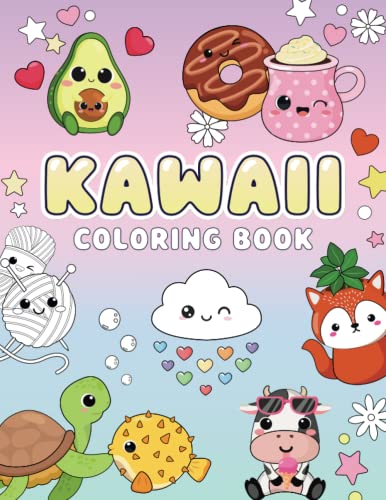Welcome to the step-by-step guide on how to protect and preserve your finished kawaii cute coloring book pages! In this guide, we will explore simple yet effective methods to ensure that your beautiful creations stay vibrant and intact for years to come. So, whether you’re a coloring enthusiast or just starting out on your kawaii coloring journey, this guide is here to help you keep your artwork looking fresh and lovely. Get ready to unleash your creativity and learn how to protect your adorable coloring book pages! But before we dive in, did you know that the word “kawaii” actually means “cute” in Japanese? Now, let’s get started on preserving your delightful masterpieces!

- Discover Adorable Cute Coloring Book Pages!
- Preserve Your Cute Coloring Book Pages Follow(7 Steps)
- 1. Choose the right art supplies
- 2. Prepare a clean work surface
- 3. Avoid direct sunlight
- 4. Use protective sleeves
- 5. Avoid excessive handling
- 6. Store in a cool, dry place
- 7. Handle with care during transportation
- Preserving your colorful creations
Discover Adorable Cute Coloring Book Pages!
Preserve Your Cute Coloring Book Pages Follow(7 Steps)
1. Choose the right art supplies
To ensure your artwork withstands the test of time, it is crucial to select high-quality coloring pencils or markers that are lightfast and acid-free. These features will prevent fading and discoloration, preserving the vibrancy of your artwork for years to come. When choosing coloring pencils, look for ones that are labeled as lightfast, meaning they resist fading when exposed to light. Additionally, opt for pencils or markers that are acid-free, as this helps prevent discoloration and yellowing of the paper. By selecting coloring supplies with these qualities, you can create artwork that remains vibrant and true to its original colors, allowing you to cherish your creations for a lifetime.
2. Prepare a clean work surface
To prepare a clean work surface, start by finding a flat and clean area to work on. This will ensure that your coloring book pages are protected from accidental spills or stains. Here are some easy-to-follow instructions to help you set up your workspace:
- Clear the area: Remove any clutter or unnecessary items from the surface. This will give you more space to work and minimize the chance of accidents.
- Clean the surface: Use a mild cleaning solution or disinfectant wipes to clean the surface of your work area. Wipe away any dust, dirt, or sticky residue that may be present. This will provide a clean canvas for your coloring book pages.
- Protect the surface: Consider using a protective covering such as a plastic tablecloth or a large sheet of paper to further safeguard your work surface. This will provide an additional layer of protection against spills or stains.
Example: If you’re working on a kitchen table, remove any plates, utensils, or food crumbs from the surface. Then, use a damp cloth and a mild dish soap to wipe down the table, removing any grease or sticky residue. Finally, cover the table with a plastic tablecloth to protect it from any accidental spills while you’re coloring.
Remember, by preparing a clean work surface, you can create a comfortable and worry-free environment for your coloring sessions.
3. Avoid direct sunlight
To protect your finished pages from fading and yellowing, it is important to store them away from direct sunlight. Prolonged exposure to sunlight can cause irreversible damage to the paper and compromise the longevity of your work.
Here’s what you need to do:
- Find a suitable storage location: Look for a cool, dry place in your home where your finished pages can be stored safely without being exposed to direct sunlight. Avoid areas near windows or skylights, as these areas are more prone to sunlight exposure.
- Use protective covers: Consider placing your finished pages in protective sleeves or archival-quality page protectors. These will not only shield your work from sunlight but also provide a barrier against dust, moisture, and other potential hazards.
- Organize your storage system: If you have multiple finished pages, it’s essential to keep them organized. Use binders, folders, or boxes to store your pages in a neat and orderly manner. Labeling and indexing can help you easily locate specific pages when needed.
- Regularly check for sunlight exposure: Even in storage, it’s important to periodically inspect your pages. Check for any signs of sunlight exposure, such as fading or discoloration. If you notice any damage, consider relocating your pages to a safer spot or investing in additional protective measures.By following these simple steps, you can ensure that your finished pages remain vibrant and pristine for years to come, preserving your hard work and cherished memories.
4. Use protective sleeves
To protect your finished pages from smudging and accidental damage, it is highly recommended that you slide each page into a clear plastic sleeve or use acid-free sheet protectors. This simple step will help preserve the quality of your documents and extend their lifespan. Here’s a clear and easy-to-follow guide to using protective sleeves:
- Gather all your finished pages that require protection.
- Locate a clear plastic sleeve or an acid-free sheet protector for each page.
- Hold the sleeve or protector open with one hand.
- Using your other hand, carefully slide one finished page into the sleeve or protector.
- Make sure the page is centered and lies flat within the sleeve or protector.
- Repeat this process for each page, ensuring they are all adequately protected.
- Once all the pages are safely inside the sleeves or protectors, store them in a designated folder or binder for added organization and convenience.
Remember, using protective sleeves is an essential step in safeguarding your documents from potential damage. By following these instructions, you can ensure that your pages remain pristine and protected for years to come.
5. Avoid excessive handling
To avoid smudging the colored areas of your finished pages, it is important to minimize touching them. Hold the pages from the edges whenever possible. This will prevent any oils or dirt from your hands transferring onto the colored areas, which can lead to smudging and a less pristine appearance. By handling the pages from the edges, you ensure that the majority of the contact is with the blank areas of the page, keeping the colored sections clean and vibrant. So remember, when enjoying your finished pages, hold them by the edges to maintain their quality and prevent smudging.
6. Store in a cool, dry place
- Find a suitable area: Look for a cool, dry place in your home or office to store your books. Avoid areas with fluctuating temperatures, such as near windows or heating vents. These can cause moisture buildup or excessive heat, leading to damage.
- Maintain consistent temperature: Ensure the chosen location maintains a stable temperature. Ideally, the temperature should be between 60-70 degrees Fahrenheit (15-21 degrees Celsius). Extreme temperature changes can cause the pages to expand and contract, leading to warping or curling.
- Control humidity levels: Aim for a relative humidity (RH) level of around 40-50% to prevent excessive moisture absorption or dryness. Too much humidity can cause mold growth, while low humidity can make paper brittle. Consider using a dehumidifier or humidifier to maintain the desired RH level if needed.
- Keep books away from moisture sources: Store your books away from areas prone to water leaks, high humidity, or excessive moisture. Bathrooms, basements, and kitchens are not suitable storage locations. Avoid storing books in areas with poor ventilation or near water pipes.
- Use bookshelves or storage containers: Invest in bookshelves or storage containers that provide proper air circulation and protection from dust. Ensure the shelves are sturdy and securely placed to avoid accidents. Avoid overcrowding the shelves, as this can lead to pressure on the books, causing damage over time.
- Avoid direct sunlight: Keep the books away from direct sunlight or strong artificial light sources. Prolonged exposure to ultraviolet (UV) rays can fade the covers and spine, as well as deteriorate the pages. Consider using curtains, blinds, or UV-protective film on windows to reduce exposure.
By following these simple guidelines, you can ensure your books remain in good condition for years to come. Remember, a stable environment plays a crucial role in preserving the quality and longevity of your beloved books.
7. Handle with care during transportation
To transport your coloring book safely, follow these steps:
- Get a protective folder or envelope: Find a folder or envelope that is large enough to fit your coloring book without folding or creasing it. Look for one that is sturdy and can provide adequate protection.
- Place your coloring book inside: Open the folder or envelope and carefully slide your coloring book inside. Make sure it is centered and laid flat to avoid any bending or creasing.
- Secure the folder or envelope: Close the folder or envelope securely, ensuring that it is tightly sealed. You can use tape or any fastening method provided by the folder or envelope.
- Handle with care: When carrying or transporting your coloring book, remember to hold it flat and avoid any rough handling or tossing. Keep it separate from any objects that could potentially damage or bend it.
By following these steps and using a protective folder or envelope, you can ensure that your coloring book remains in pristine condition during transportation.
Preserving your colorful creations
In conclusion, by following these simple steps, you can ensure the longevity and beauty of your finished kawaii coloring book pages. Remember to select high-quality supplies that won’t fade or bleed, shield your artwork from sunlight to prevent discoloration, utilize protective sleeves to safeguard against smudging and dust, handle your pages delicately to avoid creases or tears, and store them in the right conditions to maintain their vibrancy. By treating your creations with care and attention, you can enjoy your colorful masterpieces for many years to come. So go ahead, unleash your creativity, and protect and preserve your finished kawaii coloring book pages with love. Happy coloring!
Gather your supplies
- Kawaii coloring book pages
- Art supplies (colored pencils, markers, gel pens, etc.)
- Clean cloth or paper towels
- Protective sleeves or clear plastic sheets
- Storage box or folder
- Bubble wrap or cushioning material for transportation
Preserving Your Creations
- Use high-quality coloring materials: Opt for markers or colored pencils that are labeled as archival or lightfast. This will ensure that the colors on your pages will not fade over time
- Avoid direct sunlight: Sunlight can cause your coloring book pages to fade quickly. Store them in a cool, dry place away from direct sunlight to preserve their vibrancy
- Handle with clean hands: Before touching your coloring book pages, make sure your hands are clean and free from oils or lotions. This will prevent any unwanted smudges or stains
- Use protective sheets: Slip your finished coloring book pages into clear plastic sleeves or use acid-free sheet protectors. This will keep your pages safe from accidental spills or tears
- Store flat or in a binder: Avoid folding or bending your coloring book pages. Store them flat or in a binder to keep them in their original condition and prevent any creasing or damage
- Avoid humidity and moisture: Moisture can cause your coloring book pages to warp or become moldy. Keep them in a dry environment to protect them from any potential damage
- Frame your favorite pages: If you have particularly special or favorite coloring book pages, consider framing them. This will not only protect them but also allow you to display your beautiful artwork
- Keep away from pets and children: To prevent accidental damage, make sure to keep your finished coloring book pages out of reach from pets and children who may unintentionally tear or smudge them
- Clean your coloring tools regularly: If you’re using markers, make sure to clean the tips regularly to prevent any unwanted bleed or transfer of ink onto your pages
- Share digital copies: Consider scanning or taking high-quality photographs of your finished coloring book pages. This way, you can preserve them digitally and easily share them with friends and family without risking damage to the original pages












![[0]Creative Haven Vintage Hand Fans Coloring Book (Creative Haven Coloring Books)](https://bloodandcrayons.com/wp-content/uploads/2023/10/0creativehavenvintagehandfanscoloringbookcreativehavencoloring-1-379x345.jpg)
